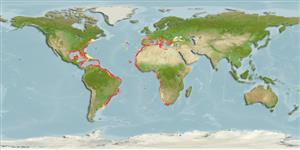>
Clupeiformes (Herrings) >
Dorosomatidae (Gizzard shads and sardinellas)
Etymology: Sardinella: Latin and Greek, sarda = sardine; name related to the island of Sardinia; diminutive (Ref. 45335).
More on author: Valenciennes.
Environment: milieu / climate zone / depth range / distribution range
بوم شناسي
دريايي; لب شور; اقیانوس رو (Ref. 51243); تغييرات عمق 0 - 350 m (Ref. 188). Subtropical; 18°C - 25°C (Ref. 2945); 47°N - 40°S, 98°W - 43°E (Ref. 54867)
Atlantic Ocean: West African coast (Ref. 2849, 3509, 5286, 121197) from Gibraltar southward to Saldanha Bay in South Africa (Ref. 188, 81269, 81631), especially in the three West African upwelling areas, from Mauritania to Guinea, from Côte d'Ivoire to Ghana and from Gabon to Angola (Ref. 121197); also in Mediterranean Sea (Ref. 188, 6683, 81631) and Black Sea (Ref. 188, 6683). In western Atlantic Ocean from Cape Cod in USA to Argentina (Ref. 188, 5286), including Bahamas, Antilles, Gulf of Mexico and the Caribbean coast (Ref. 26938).
Length at first maturity / Size / Weight / سن
Maturity: Lm 18.8, range 13 - 25 cm
Max length : 41.0 cm TL جنس نر / بدون خواص جنسي; (Ref. 825); common length : 25.0 cm SL جنس نر / بدون خواص جنسي; (Ref. 188); بيشينه وزن گزارش شده: 420.00 g (Ref. 86940); بيشينه سن گزارش شده: 7 سال ها (Ref. 839)
خارهاي باله پشتي (کل): 0; شعاع نرم باله پشتي (کل): 17-20; خارهاي باله مخرجي 0; شعاع نرم باله مخرجي: 16 - 18; مهره ها: 47 - 49. Diagnosis: Body elongate, usually subcylindrical, but sometimes a little compressed; belly rather rounded, but with a distinct keel of scutes; lower gillrakers fine and numerous, more than 80; anterior gillrakers on lower limbs of second and third gill arches lying more or less flat (Ref. 188, 2945, 81269, 81631). Flanks silvery, with a faint golden midlateral line, preceded by a faint golden spot behind gill opening; a distinct black spot at hind border of gill cover (Ref. 188). The pelvic finray count of 1 unbranched and 8 branched rays distinguishes Sardinella aurita from all other species of Sardinella, also Harengula, Opisthonema, Herklotsichthys and Amblygaster, that occur with it (Ref. 188). It resembles Clupea, but has two fleshy outgrowths along outer margin of gill opening and numerous fine fronto-parietal striae on top of head (Ref. 188).
A coastal, pelagic, species preferring clear saline waters, usually with maximum temperatures below 24°C (Ref. 27121). Found inshore and near surface to edge of shelf and down to 350m, or perhaps even deeper; schooling and strongly migratory, often rising to surface at night and dispersing (Ref. 188, 6683). It is a cold water species, temperatures between 18-25°C, approaching the coast and shoaling near the surface in the period of upwelling, but retreating below the thermocline in the hot season, down to depths of 200 to 300m (Ref. 2945, 3259). It feeds mainly on zooplankton, especially copepods and larvae of mysids, but also some phytoplankton, especially by juveniles (Ref. 188, 27121, 86940). It breeds perhaps at all times of the year, but with distinct peaks; the breeding pattern is extremely complex, with two principal spawning periods in some areas (Ref. 188). There is no spawning in Black Sea (Ref. 6683). The juveniles tend to stay in nursery areas, but on maturity rejoin adult stocks in the colder offshore waters (Ref. 188). Trematode found in intestinal tract (Ref. 37032).
The breeding pattern is extremely complex, with two principal spawning periods in some areas (linked with upwelling regimes off west Africa).
Whitehead, P.J.P., 1985. FAO Species Catalogue. Vol. 7. Clupeoid fishes of the world (suborder Clupeoidei). An annotated and illustrated catalogue of the herrings, sardines, pilchards, sprats, shads, anchovies and wolf-herrings. FAO Fish. Synop. 125(7/1):1-303. Rome: FAO. (Ref. 188)
وضعيت در فهرست قرمز IUCN (Ref. 130435)
خطر برای انسان ها
Harmless
استفاده انسانی
ماهي گيري – شيلات: با ارزش تجاري بالا; طعمه: usually
ابزارها
گزارش های ويژه
بارگيری XML
منابع اينترنتي
Estimates based on models
Preferred temperature (Ref.
123201): 13.3 - 26.3, mean 18.8 °C (based on 552 cells).
Phylogenetic diversity index (Ref.
82804): PD
50 = 0.5000 [Uniqueness, from 0.5 = low to 2.0 = high].
Bayesian length-weight: a=0.00724 (0.00630 - 0.00834), b=3.03 (3.00 - 3.06), in cm total length, based on LWR estimates for this species (Ref.
93245).
Trophic level (Ref.
69278): 3.4 ±0.5 se; based on diet studies.
Generation time: 2.5 (2.1 - 3.1) years. Estimated as median ln(3)/K based on 31
growth studies.
جهندگی (Ref.
120179): زياد, كمينه زمان لازم براي دو برابر شدن جمعيت ، كمتر از 15 ماه (K=0.25-1.2; tm=1; tmax=7).
Prior r = 0.74, 95% CL = 0.46 - 1.16, Based on 12 stock assessments.
Fishing Vulnerability (Ref.
59153): Low to moderate vulnerability (29 of 100).
Climate Vulnerability (Ref.
125649): Low vulnerability (7 of 100).
Nutrients (Ref.
124155): Calcium = 89 [50, 191] mg/100g; Iron = 1.46 [0.87, 2.44] mg/100g; Protein = 21.6 [20.9, 22.4] %; Omega3 = 0.541 [0.271, 1.052] g/100g; Selenium = 63.2 [32.8, 112.9] μg/100g; VitaminA = 13.1 [4.2, 39.8] μg/100g; Zinc = 0.656 [0.490, 0.983] mg/100g (wet weight); based on
nutrient studies.
